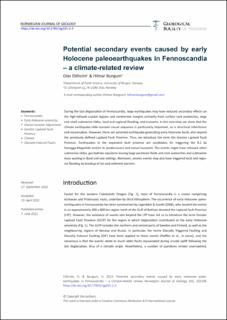Potential secondary events caused by early Holocene paleoearthquakes in Fennoscandia – a climate-related review
Journal article, Peer reviewed
Published version

Åpne
Permanent lenke
https://hdl.handle.net/11250/2984650Utgivelsesdato
2021Metadata
Vis full innførselSamlinger
- Department of Earth Science [1103]
- Registrations from Cristin [10412]
Originalversjon
Norwegian Journal of Geology. 2021, 101, 202108. https://dx.doi.org/10.17850/njg101-2-3Sammendrag
During the last deglaciation of Fennoscandia, large earthquakes may have induced secondary effects on the high-latitude coastal regions and continental margins primarily from surface rock avalanches, large and small submarine slides, local and regional flooding, and tsunamis. In this overview, we show that the climate-earthquake-slide-tsunami causal sequence is particularly important, as is structural inheritance and rejuvenation. However, there are potential earthquake-generating early Holocene faults also beyond the previously defined Lapland Fault Province. Thus, we introduce the term the Greater Lapland Fault Province. Earthquakes in the expanded fault province are candidates for triggering the 8.1 ka Storegga Megaslide and/or its predecessors and coeval tsunamis. The events might have released other submarine slides, gas hydrate expulsion leaving large pockmark fields, rock avalanches and submarine mass wasting in fjord and lake settings. Moreover, the seismic events may also have triggered local and regional flooding by breakup of ice and sediment barriers.
